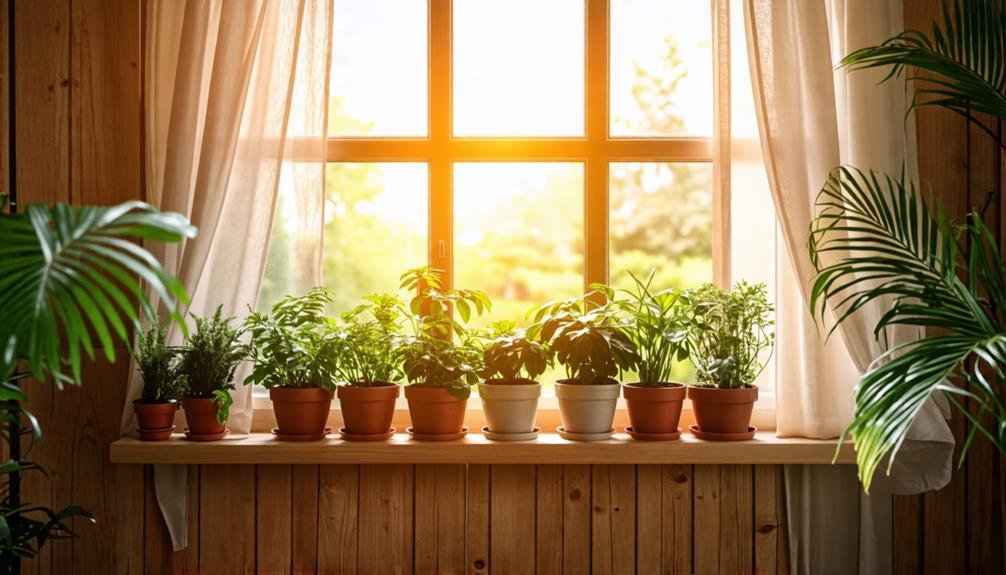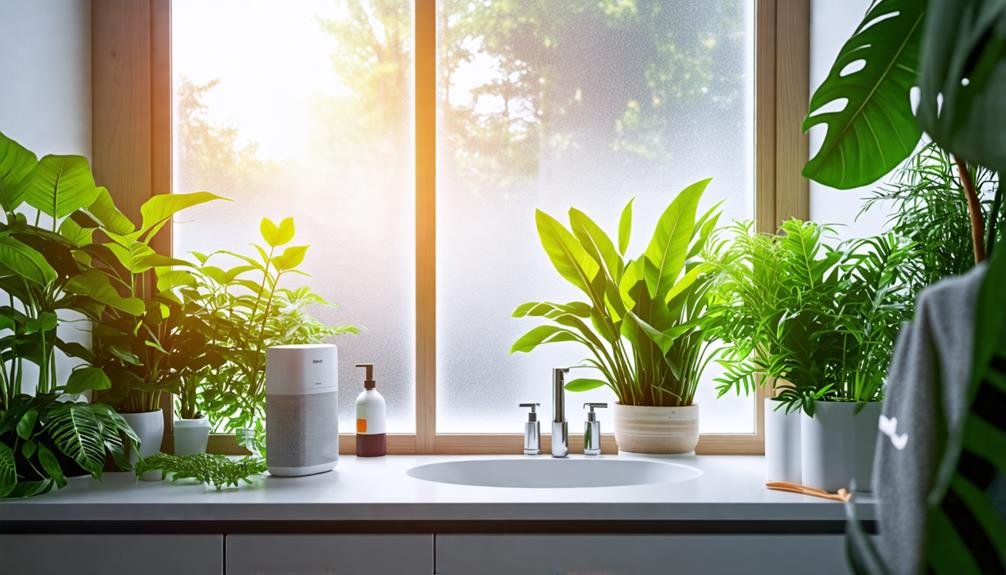Companion planting is an effective strategy for combating summer heat by using shade-providing plants. These plants not only create a cooler environment but also improve pest control and boost soil health through beneficial interactions. For example, tall, leafy species can cast shade on more sensitive crops, mitigating heat stress and promoting peak growth. Choosing heat-tolerant varieties ensures resilience, while incorporating diverse plant combinations promotes biodiversity. Moreover, layering plants and using climbing species can enhance shade coverage in your garden. Exploring these methods can offer deeper insights into creating a thriving, sustainable garden during the scorching summer months.
Understanding Companion Planting
Companion planting involves selecting plant species that coexist harmoniously. This strategy provides mutual benefits like shade, improved growth, and pest control. This gardening practice fosters sustainability, allowing plants to support each other and enhance garden health. By choosing companion plants carefully, gardeners create natural shade that protects delicate crops from intense sunlight and heat, especially during the hot summer months.
For example, tall crops such as Zea mays (corn) can shade smaller plants like Allium cepa (onions) or Petroselinum crispum (parsley), effectively minimizing heat stress. Additionally, certain plant combinations enrich soil quality, promoting nutrient exchange and enhancing growth conditions. Implementing gardening tips, such as utilizing shade-providing companions, can significantly bolster garden resilience.
Furthermore, companion planting promotes biodiversity, leading to a balanced ecosystem and reduced pest populations. This method not only nurtures a flourishing garden but also allows for experimentation with various plant combinations, encouraging creative expression. Ultimately, applying the principles of companion planting opens pathways for effective gardening, ensuring that both edible species and ornamental flora thrive under the summer sun while benefiting from natural shade.
Shade-Loving Ornamental Plants
Shade-loving ornamental plants play a pivotal role in creating a cooler garden environment, especially during the hot summer months. Species such as ostrich fern, goats beard, bleeding hearts, and monkshood not only thrive in low-light conditions but also help mitigate heat stress in surrounding plants. Monitoring these plants for signs of heat stress is vital, ensuring a vibrant and healthy landscape even in extreme weather conditions.
Ideal Shade Plants
Creating a serene and visually pleasing garden can be enhanced by incorporating ideal shade plants that flourish in low-light conditions. These flora not only beautify your environment but also provide a practical solution during the sweltering summer months. Choosing the right shade-loving ornamental species ensures a more comfortable microclimate, alleviating heat stress on nearby vegetation.
Some outstanding choices include the Matteuccia struthiopteris, commonly known as ostrich fern, celebrated for its lush fronds, and Lamprocapnos spectabilis, or bleeding hearts, which showcase delicate, heart-shaped flowers. Aconitum, known as monkshood, with its vivid blue blossoms, introduces an element of drama, while Aruncus dioicus, or goatsbeard, offers a feathery texture that softens garden borders. These plants thrive in partial to full shade and withstand the challenges of warmer weather.
Beyond their aesthetic appeal, these plants serve as natural sun barriers for more sensitive species within the garden. When positioned thoughtfully, they create a layered effect, ensuring that even the most delicate plants receive sufficient protection from the harsh summer sun. By integrating these ideal shade plants into your landscape, you can cultivate a vibrant garden that flourishes despite the obstacles presented by rising temperatures.
Heat Stress Monitoring
Gardeners can effectively monitor heat stress in shade-loving ornamental plants, such as hostas and ferns, to protect their health during extreme weather conditions. Regular observation is essential. Signs of heat stress may manifest as wilting, leaf scorch, or discoloration, indicating that plants are struggling in high temperatures. Gardeners should assess soil moisture levels, as dry soil can exacerbate stress. Consistent watering schedules, particularly during heat waves, are vital for plant resilience.
Using digital thermometers or soil moisture meters can provide precise data on environmental conditions. Additionally, employing shading techniques, such as utilizing taller companion plants like sunflowers or installing trellises with climbing varieties like clematis, can create a more stable microclimate, minimizing heat exposure. Monitoring the interaction between companion plants and shade-loving species can reveal effective combinations for optimal protection.
Furthermore, applying organic mulch, such as wood chips or straw, around the base of plants can conserve soil moisture and regulate temperature. By closely observing plant health and implementing these strategies, gardeners can cultivate a thriving environment for shade-loving ornamental plants, ensuring their longevity and beauty even during extreme heat. This proactive approach not only preserves plant vitality but also enhances the overall aesthetic of the garden throughout the sweltering summer months.
Protecting Edible Crops From Heat

Protecting edible crops from extreme heat is crucial for maintaining their health and productivity during the summer months. Utilizing shade-providing companion plants can effectively mitigate heat stress, particularly for cool-weather varieties like spinach and cilantro that struggle in direct sunlight. By strategically incorporating taller crops, such as corn, alongside shade-sensitive plants, gardeners can create a more conducive environment for all their crops, ensuring a bountiful harvest.
Shade-Providing Companion Plants
Shade-providing companion plants are crucial for protecting edible crops from intense heat, promoting optimal growth and resilience. These plants offer physical shade and create a microclimate that lowers soil temperatures, minimizing stress on delicate crops. For example, tall crops like Zea mays (corn) effectively shade heat-sensitive plants such as Coriandrum sativum (cilantro) and Spinacia oleracea (spinach), allowing them to flourish even in scorching summer conditions.
Certain plants, such as Solanum lycopersicum (tomatoes) and Cucurbita pepo (squash), provide edible yields while also casting shade on neighboring crops. Strategically placing these companion plants can create a multi-layered garden environment, maximizing space and enhancing productivity. Utilizing climbing plants, like Clematis or climbing roses from the David Austin brand, on trellises can optimize vertical space and shade coverage.
When selecting shade-offering companions, assess which crops need protection and choose plants that thrive in sunny conditions. This careful selection promotes healthy growth and fosters a diverse ecosystem, bolstering the garden's resilience against extreme heat.
Heat Stress Mitigation Strategies
Implementing strategies to mitigate heat stress is essential for protecting edible plants from the negative impacts of high temperatures. As climate patterns evolve and heat waves increase in frequency, knowing how to shield your crops becomes crucial. Various techniques can be used to ensure your plants flourish even in extreme conditions:
- Engage in companion planting by pairing taller crops, like sunflowers, with shorter varieties, such as lettuce, to provide natural shade.
- Set up shade cloth from brands like AgroFabric to shield against harsh sunlight and lower soil temperature.
- Water wisely, ensuring your crops, like tomatoes, receive sufficient moisture while avoiding overwatering that could lead to root rot.
- Apply mulch, such as straw or wood chips, around plants to help regulate soil temperature and retain moisture.
Benefits of Companion Planting
Companion planting provides numerous benefits, including enhanced plant growth, effective pest management, and improved soil health. By carefully arranging specific plant varieties together, gardeners can cultivate a micro-ecosystem that fosters vitality. For instance, sunflowers can offer shade to sensitive plants like lettuce, alleviating heat stress and creating a more favorable growing environment. This shading not only safeguards delicate crops but also encourages beneficial relationships that enhance nutrient absorption.
Moreover, companion planting acts as a natural barrier against pests. Certain plant pairings can confuse or deter insects, minimizing the reliance on chemical pesticides. For example, planting French marigolds can ward off harmful nematodes and aphids, safeguarding nearby vegetables such as tomatoes and peppers.
In addition, companion planting contributes to enriched soil health. Leguminous plants, such as clover, naturally fix nitrogen in the soil, benefiting neighboring crops like corn and squash. This organic enrichment reduces the need for synthetic fertilizers, promoting more sustainable gardening practices.
Ultimately, companion planting is a creative strategy for enhancing garden ecosystems, offering benefits that go beyond aesthetics and shade. By adopting this method, gardeners like those using the Back to Eden gardening philosophy can cultivate vibrant, interconnected ecosystems that thrive together.
Selecting Suitable Companion Plants

Selecting suitable companion plants involves careful consideration of the needs of delicate species and the compatibility of potential partners within the garden ecosystem. Choosing plants that provide shade and coexist well can enhance your garden's resilience against extreme temperatures. Begin by identifying plants in your garden that require sun protection and explore appropriate companions.
Consider the following aspects when selecting your companion plants:
- Height and Width: Choose towering varieties like Helianthus (sunflowers) or Zinnia elegans (zinnias) that can create significant cover.
- Growth Conditions: Ensure that selected plants, such as Petunia (petunias) or Salvia (sages), thrive under similar soil and moisture conditions.
- Compatibility: Opt for companions that do not compete for resources, like nutrients and water, such as Cucumis sativus (cucumbers) alongside Solanum lycopersicum (tomatoes).
- Heat Tolerance: Include plants like Zea mays (corn) or Capsicum annuum (bell peppers), which can endure high temperatures while providing shade for more sensitive species.
Practical Tips for Natural Shade
Creating natural shade in your garden requires careful selection of flora that offers cover for sensitive plants while also thriving under sunny conditions. Choose companions like viburnums or lilacs, which are robust and can withstand harsh weather, to form a protective canopy over smaller species.
Utilizing climbing varieties such as clematis or climbing roses on trellises can also enhance your garden's shade. These vertical growers optimize space while providing a cool retreat from the heat. Additionally, consider strategic positioning of your edible crops; for example, tomatoes can serve as a shield for onions and carrots against intense sunlight.
It's crucial to keep an eye on your plants for indicators of heat stress during extreme weather, enabling prompt action to safeguard them. By integrating diverse plant types—shrubs, climbers, and taller crops—you create a multi-layered shade system, maintaining a lively and sustainable garden. Implementing these practical strategies will allow you to effectively use companion planting to combat summer heat naturally.
Creative Garden Design Ideas

Innovative garden design transforms sun-drenched areas into tranquil retreats, enhancing both beauty and practicality through strategic plant combinations and well-planned layouts. By incorporating shade-giving companions, you elevate visual charm and foster microclimates that support both decorative and edible flora.
Explore these inventive design concepts to maximize shade and allure:
- Layered Planting: Employ towering plants like Zea mays (corn) or Helianthus annuus (sunflowers) to create a vertical shade canopy over shorter companions.
- Trellis Structures: Add climbing species such as Clematis or Phaseolus vulgaris (beans) on trellises to produce vertical shade while enhancing garden depth.
- Mixed Borders: Craft borders with a blend of tall shrubs like Hydrangea and shorter, shade-tolerant plants such as Helleborus to achieve a rich, layered appearance.
- Pathway Canopies: Position arching vines like Wisteria over walkways to create inviting shaded paths that encourage exploration.


















You must be logged in to post a comment Login